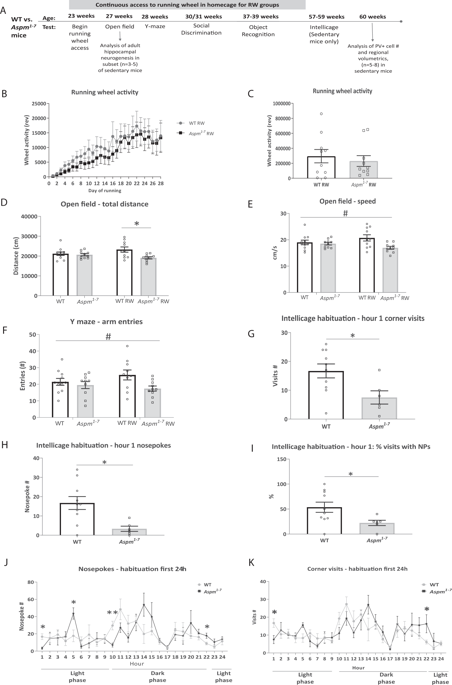当前位置:
X-MOL 学术
›
Transl. Psychiaty
›
论文详情
Our official English website, www.x-mol.net, welcomes your
feedback! (Note: you will need to create a separate account there.)
A truncating Aspm allele leads to a complex cognitive phenotype and region-specific reductions in parvalbuminergic neurons.
Translational Psychiatry ( IF 5.8 ) Pub Date : 2020-02-13 , DOI: 10.1038/s41398-020-0686-0 Lillian Garrett 1, 2 , Yoon Jeung Chang 3 , Kristina M Niedermeier 1 , Tamara Heermann 1 , Wolfgang Enard 4 , Helmut Fuchs 2, 5 , Valerie Gailus-Durner 2, 5 , Martin Hrabě de Angelis 2, 5, 6, 7 , Wieland B Huttner 3 , Wolfgang Wurst 1, 8, 9, 10 , Sabine M Hölter 1, 2
Translational Psychiatry ( IF 5.8 ) Pub Date : 2020-02-13 , DOI: 10.1038/s41398-020-0686-0 Lillian Garrett 1, 2 , Yoon Jeung Chang 3 , Kristina M Niedermeier 1 , Tamara Heermann 1 , Wolfgang Enard 4 , Helmut Fuchs 2, 5 , Valerie Gailus-Durner 2, 5 , Martin Hrabě de Angelis 2, 5, 6, 7 , Wieland B Huttner 3 , Wolfgang Wurst 1, 8, 9, 10 , Sabine M Hölter 1, 2
Affiliation

|
Neurodevelopmental disorders are heterogeneous and identifying shared genetic aetiologies and converging signalling pathways affected could improve disease diagnosis and treatment. Truncating mutations of the abnormal spindle-like microcephaly associated (ASPM) gene cause autosomal recessive primary microcephaly (MCPH) in humans. ASPM is a positive regulator of Wnt/β-Catenin signalling and controls symmetric to asymmetric cell division. This process balances neural progenitor proliferation with differentiation during embryogenesis, the malfunction of which could interfere with normal brain development. ASPM mutations may play a role also in other neurodevelopmental disorders, nevertheless, we lack the details of how or to what extent. We therefore assessed neurodevelopmental disease and circuit endophenotypes in mice with a truncating Aspm1-7 mutation. Aspm1-7 mice exhibited impaired short- and long-term object recognition memory and markedly enhanced place learning in the IntelliCage®. This behaviour pattern is reminiscent of a cognitive phenotype seen in mouse models and patients with a rare form of autism spectrum disorder (ASD) as well as in mouse models of altered Wnt signalling. These alterations were accompanied by ventriculomegaly, corpus callosum dysgenesis and decreased parvalbumin (PV)+ interneuron numbers in the hippocampal Cornu Ammonis (CA) region and thalamic reticular nucleus (TRN). PV+ cell number correlated to object recognition (CA and TRN) and place learning (TRN). This opens the possibility that, as well as causing MCPH, mutant ASPM potentially contributes to other neurodevelopmental disorders such as ASD through altered parvalbuminergic interneuron development affecting cognitive behaviour. These findings provide important information for understanding the genetic overlap and improved treatment of neurodevelopmental disorders associated with ASPM.
中文翻译:

截断 Aspm 等位基因会导致小白蛋白能神经元出现复杂的认知表型和区域特异性减少。
神经发育障碍是异质的,识别共同的遗传病因和受影响的信号通路可以改善疾病的诊断和治疗。异常纺锤样小头畸形相关 (ASPM) 基因的截断突变导致人类常染色体隐性遗传原发性小头畸形 (MCPH)。ASPM 是 Wnt/β-Catenin 信号传导的正调节剂,控制对称到不对称的细胞分裂。这一过程在胚胎发生过程中平衡了神经祖细胞的增殖和分化,其故障可能会干扰正常的大脑发育。ASPM 突变也可能在其他神经发育障碍中发挥作用,然而,我们缺乏如何或在何种程度上的细节。因此,我们评估了具有截断 Aspm1-7 突变的小鼠的神经发育疾病和回路内表型。Aspm1-7 小鼠在 IntelliCage® 中表现出短期和长期物体识别记忆受损和显着增强的地方学习能力。这种行为模式让人想起在小鼠模型和患有罕见自闭症谱系障碍 (ASD) 的患者以及 Wnt 信号改变的小鼠模型中看到的认知表型。这些改变伴随着脑室扩大、胼胝体发育不全和海马海马角 (CA) 区域和丘脑网状核 (TRN) 中的小白蛋白 (PV) + 中间神经元数量减少。PV+ 细胞数与物体识别(CA 和 TRN)和位置学习(TRN)相关。这开启了一种可能性,即除了引起 MCPH,突变的 ASPM 通过改变影响认知行为的小白蛋白能中间神经元发育可能导致其他神经发育障碍,如 ASD。这些发现为了解与 ASPM 相关的神经发育障碍的遗传重叠和改进治疗提供了重要信息。
更新日期:2020-02-13
中文翻译:

截断 Aspm 等位基因会导致小白蛋白能神经元出现复杂的认知表型和区域特异性减少。
神经发育障碍是异质的,识别共同的遗传病因和受影响的信号通路可以改善疾病的诊断和治疗。异常纺锤样小头畸形相关 (ASPM) 基因的截断突变导致人类常染色体隐性遗传原发性小头畸形 (MCPH)。ASPM 是 Wnt/β-Catenin 信号传导的正调节剂,控制对称到不对称的细胞分裂。这一过程在胚胎发生过程中平衡了神经祖细胞的增殖和分化,其故障可能会干扰正常的大脑发育。ASPM 突变也可能在其他神经发育障碍中发挥作用,然而,我们缺乏如何或在何种程度上的细节。因此,我们评估了具有截断 Aspm1-7 突变的小鼠的神经发育疾病和回路内表型。Aspm1-7 小鼠在 IntelliCage® 中表现出短期和长期物体识别记忆受损和显着增强的地方学习能力。这种行为模式让人想起在小鼠模型和患有罕见自闭症谱系障碍 (ASD) 的患者以及 Wnt 信号改变的小鼠模型中看到的认知表型。这些改变伴随着脑室扩大、胼胝体发育不全和海马海马角 (CA) 区域和丘脑网状核 (TRN) 中的小白蛋白 (PV) + 中间神经元数量减少。PV+ 细胞数与物体识别(CA 和 TRN)和位置学习(TRN)相关。这开启了一种可能性,即除了引起 MCPH,突变的 ASPM 通过改变影响认知行为的小白蛋白能中间神经元发育可能导致其他神经发育障碍,如 ASD。这些发现为了解与 ASPM 相关的神经发育障碍的遗传重叠和改进治疗提供了重要信息。











































 京公网安备 11010802027423号
京公网安备 11010802027423号